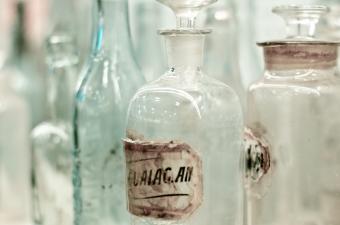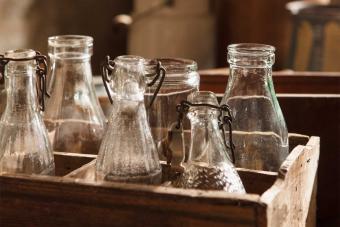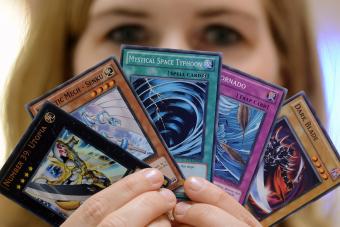Learn How to Identify Old Bottles

If you've found an old bottle in your attic, discovered a treasure buried in your backyard, or simply want to satisfy your curiosity about an antique bottle you've had for a while, the key is looking closely at what you have. Old bottle identification is all about careful observation. Take some time to look at the bottle carefully and ask yourself a few questions about it.
Note What Size of Old Bottle You Have

Bottles have been around for centuries, and they come in all different shapes and sizes. This is the first clue about your bottle's age and use. A large bottle may have contained anything from household chemicals to beer, but it will usually be something that was used in large quantities. A small bottle might have held pills, a hair tonic, shoe polish, or anything else you use only a little of at a time.
Consider the Shape of an Antique Bottle

Shape also offers some clues to help you identify an old bottle. According to the Historic Glass Bottle Identification and Information Website, there's a science to the shape of bottles. The opening size, neck length, and other dimensions are all related to the type of contents the bottles held. What's more, certain shapes are clearly linked to specific types of products. Consider these examples:
- Milk bottles tend to have wide, round mouths that would have held a paper or metal cap.
- Liquor flasks tend to be flat bottles with small openings.
- Soda bottles often have long necks and round bodies.
- Ink bottles are generally small and squat with wide mouths.
It's important to note that bottles might actually have held something entirely different from what their shape might indicate. However, identifying the most likely contents for that bottle shape is a good starting point.
Pay Attention to the Colors of Old Bottles

You'll find old bottles in colorless varieties, as well as a wide range of colors, including amber, blue, purple, and green. Sometimes color served a purpose that's related to the contents of the bottle. For example, some amber and other dark bottles may be that color because the contents were sensitive to light. However, color often has nothing to do with the bottle's original purpose.
Even if it doesn't offer clues about what the bottle was used for, color is important for describing a bottle and assessing its value. It can also help you date the bottle. For instance, old green glass bottles come in lots of different shades of green. A certain shade that matches the green of 7-Up bottles can indicate the bottle is probably from the 20th century.
If you have an old bottle that is a distinctive color, it's a good idea to do some more research about when that color may have been used.
Look for Old Bottle Labels and Embossing

Some old bottles feature all or part of the original label. This can provide a lot of information about the bottle's age and original purpose. Even if you only have part of the label, you can do a quick Google search to see if you can learn more.
You can also use any embossing to identify an old bottle. This is even more reliable than a label, since embossing is part of the glass itself and not something that could become worn or illegible over time. If you have trouble reading an embossing on an old bottle, you can place a piece of thin tissue paper over it and rub it with a crayon.
Check for Caps and Stoppers on Old Bottles

Many old bottles don't have a cap, lid, or stopper. However, if you encounter a bottle that does, this is an important feature to note. The type of cap or stopper can help identify an old bottle and make it easier to describe it if you plan to sell it or trade it. There are lots of ways bottles could be capped or closed, including the following:
- Glass stoppers - These pieces of rounded glass allowed someone to control the pour of the contents using pressure. They also didn't corrode with time or use, which means they tend to be in good condition if they haven't been lost.
- Metal caps - Although original metal caps can become rusty or damaged, it's still possible to find old bottles with their original lids.
- Paper caps - Some types of old bottles, such as milk bottles, sometimes came with paper or cardboard caps. These are quite rare to find intact.
Identify the Markings on the Bottom of Old Bottles

Many antique bottles feature marks or numbers on the underside of the bottle. Take a moment to examine any markings very closely, since they can provide a lot of information about the bottle. Use a magnifying glass or do a rubbing with tissue paper if you can't see the marking clearly. Then learn about the type of markings on old bottles to gain a little more information about the bottle's history.
Look at the Lip of the Bottle

The mouth or lip of an antique bottle can also give you lots of information about it. Examine the quality and uniformity of the opening. Is it perfectly round? If not, it could be hand blown.
Also check to see if there are mold lines, which can be easy to see in this part of the bottle. Mold lines are little lines that go up either side of the bottle, all the way to the mouth or lip. They show that the bottle was blown into a mold, which could then be opened to remove it when it cooled. If the mold lines go all the way to the lip, it is probably a fairly recent example.
Examine the Thickness of the Glass

Another important factor in identifying old bottles is the thickness of the glass. Thinner glass was more delicate, which can mean it was used for something less likely to be knocked around. Thicker glass was common for utilitarian purposes, such as household cleaners. Bottles with thicker glass may have also been intended for reuse, as is the case with soda, milk, or beer bottles.
Sign up for our newsletter featuring all the latest stories and products we love.
Cautiously Examine the Contents of Old Bottles

Sometimes, you may encounter an old bottle that still has something inside it. The contents can give you lots of information about what the bottle may have held, but they can also be dangerous. It may be obvious that what's inside the bottle is a cordial or extract, but it could also be poison. If you're going to open the bottle, do it outside in a well-ventilated area. Don't dump contents if you aren't sure what they are, since they may be hazardous. Also, avoid directly inhaling or touching anything in an old bottle.
Consider the Bottle's Recent History

While learning the original purpose or age is important for old bottle identification, it doesn't tell the whole story of a bottle. Many bottles were reused, often for purposes that had nothing to do with their original intent. Although you can't determine everything a bottle might have held, it's good to remember that it could have been multiple things.
You can also find clues about the bottle's recent history based on where it was found. If the bottle has dirt or dust on the inside, it may be a "dug" bottle, or one a bottle-hunter found in an old dump. If it has significant cloudiness and a softening of the edges and surfaces, it may have been in water for a long time.
Find Out if an Old Bottle Is Valuable

If you know how to identify an old bottle, you can begin to get a sense of whether it's valuable. There are lots of factors that can affect antique bottle values, and only a few old bottles are worth more than $25 or so. However, money isn't the only way to assign value to something. Although some old bottles aren't worth a lot of money, they can make beautiful decorations in your home. You might also want to explore some rare, valuable jars to inspire your collector's heart.







